Morning Moon Covers Planets, Spotty Saturn, Bring Out the Binoculars, and Mercury Mounts After Sunset!
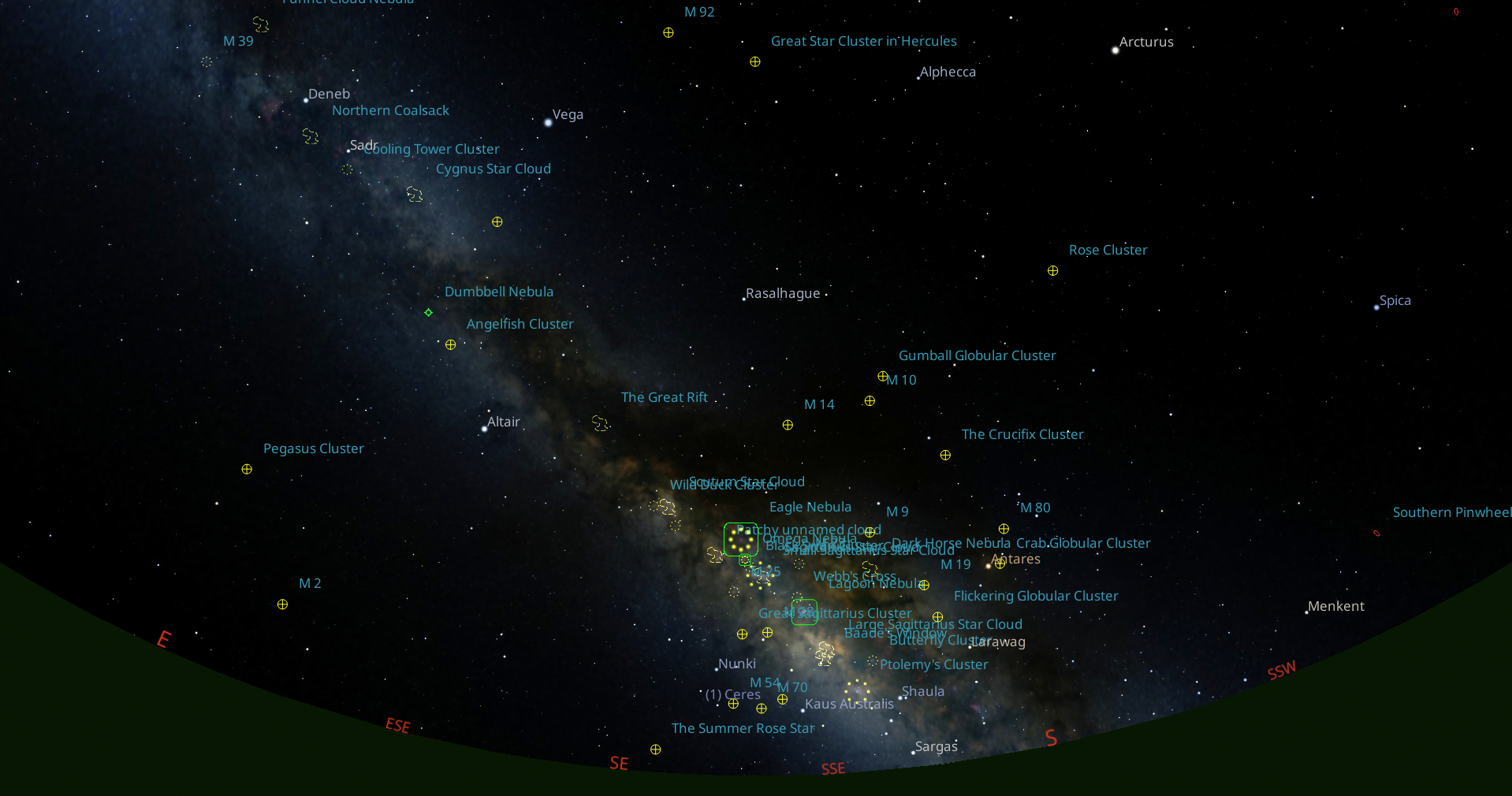
This view of the southern evening sky at 11 pm local time for the latitude of Toronto shows how the Milky Way rises from the southern horizon and arcs across the eastern sky at this time of the year. The coloured symbols and labels are a selection of the brighter deep sky objects sprinkled available for viewing. Most of them are visible in binoculars from dark sky locations. Deep sky objects include globular star clusters (yellow circles with crosses), nebulae (outlined in yellow or green), and star clusters (yellow dotted circles). You will almost certainly stumble upon one of them if you sweep the sky with binoculars or a telescope equipped with a low power eyepiece.
Greetings, Early Summer Stargazers!
Here are your Astronomy Skylights for the week of June 23rd, 2024 by Chris Vaughan. Feel free to pass this along to your friends and send me your comments, questions, and suggested topics. You can also follow me on Twitter as @astrogeoguy! Unless otherwise noted, all times are expressed in Eastern Time. To subscribe to these emails please click this MailChimp link.
If you’d like me to bring my Digital Starlab portable inflatable planetarium to your school or other daytime or evening event in Simcoe, Grey, and Bruce Counties, or deliver a virtual session anywhere, contact me through AstroGeo.ca, and we’ll tour the Universe, or the Earth’s interior, together! My book with John A. Read entitled 110 Things to See With a Telescope is a guide to viewing the deep sky objects in the Messier List – for both beginners and seasoned astronomers. DM me to order a signed copy!
The bright moon will gradually shift into the post-midnight sky this week, where it will start its monthly visit with the pre-dawn planets, occulting several of them as it goes. Saturn will encounter our moon, and one of its own will cast a shadow on its globe. The rest of the outer planets will rise after Saturn, but the inner planets will start to enter the western sky after sunset. Darker skies brings out the summer Milky Way, so I offer some advice on buying and using binoculars. Read on for your Skylights!
Summer is Binoculars Season
When you are known as an astronomer, you are often asked what kind to telescope to buy for beginners or kids. Those of us who practice astronomy outreach and education usually suggest starting out with binoculars. There is plenty to discover in the sky with them, and if astronomy doesn’t spark an interest, binoculars can still be used for sports, bird watching, sightseeing, etc.

There are plenty of excellent sights to see in the sky all year round – but the summertime Milky Way is especially rewarding for binoculars. Even from less than perfectly dark skies, one can discover knots of glittering star clusters just by sweeping your binoculars slowly across the southern sky. Viewing from a cottage or farm country will add in the many bright nebulae that dot the Milky Way. Let’s look at some tips for buying and/or using binoculars for stargazing.
Many people are tempted to pick up a telescope at a big box store, but most of those telescopes are junk, to be honest. They have plastic parts that are easily worn out or broken, use inferior optics that deliver only blurry views, and are often mounted on rickety tripods that shake at the merest touch. On the other hand, you can buy a very fine pair of binoculars for the price of a junk telescope.
Binoculars are terrific for beginners because they deliver a magnified view of the sky that is not mirrored and/or inverted as it would be in an astronomical telescope. The moon looks the same, only larger, and stars are arranged in the same way they look to your unaided eyes. That makes locating and finding things much easier. I often look at something without binoculars, then view it through them, then without them, and go back and forth. Examining wide swaths of the sky will also get you used to noticing aspects of the sky at times when you are just strolling about and looking up.
Two-eyed viewing is more relaxing than one-eyed and makes seeing dimmer objects easier, too. Binoculars can be easier for youngsters to use, since young children don’t develop the ability to peer into an eyepiece with only one eye until they are about 7 years old.
Over the span of a year, unaided human eyes are able to see a few thousand of the stars in a perfectly dark night sky (to a magnitude value of about 6.0). That quantity drops to only a few hundred stars under suburban skies. Binoculars will show you far more stars, even under city skies. In fact, at least 200,000 stars shine in the binoculars range of magnitude 9.0 or brighter.
Binoculars’ field of view (or FOV) can span 3 to 10 degrees, but usually show you 5 to 7 degrees of the sky. That allows large sections of big constellations or the entirety of small ones to be viewed through them. A larger FOV makes it easier to find dimmer targets by “star hopping” away from bright stars. Their wide field of view also allows you to stumble upon objects in the sky. Comets are especially good in binoculars, too. Actually, many celestial sights are too large to squeeze into the small 1-2° field of view provided by a backyard telescope. The Andromeda Galaxy (Messier 31), the Double Cluster in Perseus, and the Pleiades in Taurus look much better in binoculars!
Any pair of binoculars can be used for astronomy, but you should keep an eye out for certain features when planning to stargaze with them. Binoculars are characterized using a pair of numbers separated with an “x”. The “10” in 10×50 is the amount of magnification or power, i.e., things will look ten times larger/closer. For astronomy, 8x and 10x are ideal. Lower power binoculars are less sensitive to shaky hands and provide the widest fields of view. Higher powers are better for seeing smaller craters on the moon, stripes on Jupiter, and a hint of Saturn’s rings.
The “50” in 10×50 is the aperture or diameter of the main lenses, expressed in mm. For astronomy, try to buy at least 42 or 50 mm if you plan to hold them with your hands. 70-80 mm aperture whoppers will be heavy and perform like twin telescopes, but you’ll probably need to mount them on a tripod or prop them on a railing or post for handheld views longer than a moment or two.
The amount of sky the binoculars will show you comes from their apparent field of view in degrees or the angular field of view expressed as “xx-metres at 1,000-metres” or “xxx-ft at 1,000-yards”. Ideally, you’ll want see a 6° to 8° diameter patch of sky. 368-feet at 1,000-yards and 122-metres at 1,000-metres both produce a 7° diameter field. Look for apparent field values of 65° or greater and the aperture that you can comfortably hold up to your eyes and carry around.
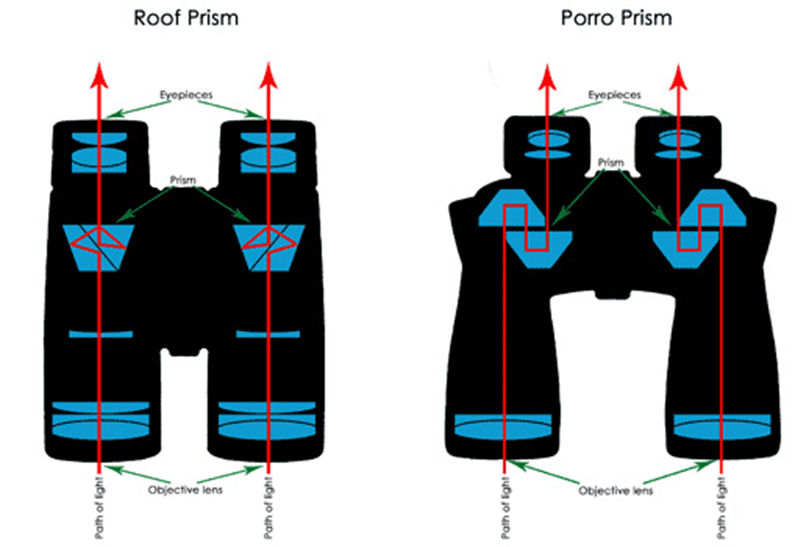
There are two main binoculars types. Porro Prism are the traditional type, containing prisms to bounce the light inside them. They tend to be entry-level models nowadays. The zig-zag path that the light makes passing through them allows the eye lenses to be closer together to accommodate youngsters. The prisms make them heavier and prone to damage if knocked around, but they offer a better 3D effect and wider FOVs.
Roof Prism binoculars are more popular nowadays. The lack of prisms makes them slimmer, lighter, and gives brighter views, but they also provide a narrower FOV and less 3D effect. For either type, higher-priced models get better glass and coatings.
Other features to shop for are: BAK-4 glass lenses versus cheaper BK-7 glass, which has less edge-to-edge sharpness; waterproof for those dewy nights, twist-up eyecups to block stray light, independent focus if your two eyes have different prescriptions, 14mm or more of eye relief (especially if you wear glasses), and a tripod mounting bracket hole. Every surface of a lens or prism reflects and scatters light, so quality coatings make a big difference in brightness and contrast for dim-light viewing.
The diameter of our pupil controls how much light enters the eye. Older eyes dilate less than youthful ones. The size of the light beam that enters your eye from binoculars or a telescope is called exit pupil. The 7×50 binoculars’ 7 mm exit pupil diameter is fine for younger eyes, but the 5 mm exit pupil in 10×50 binoculars is better for aging eyes.
Binoculars work because their two “telescopes” are pointed in exactly the same direction – or collimated. If possible, test-view binoculars in the store to ensure that you can achieve a crisp, focused image in both eyes. Zoom binoculars tend to deliver a range of magnifications by skimping on the optics quality – I’d avoid them. And finally, for the Cadillac of binoculars, you can invest in a good pair of image stabilized binoculars. Quality models from Canon and other vendors cost as much as a quality telescope, but they perform par excellence, as if they are much larger. I have the Canon 10×42 L IS WP model.
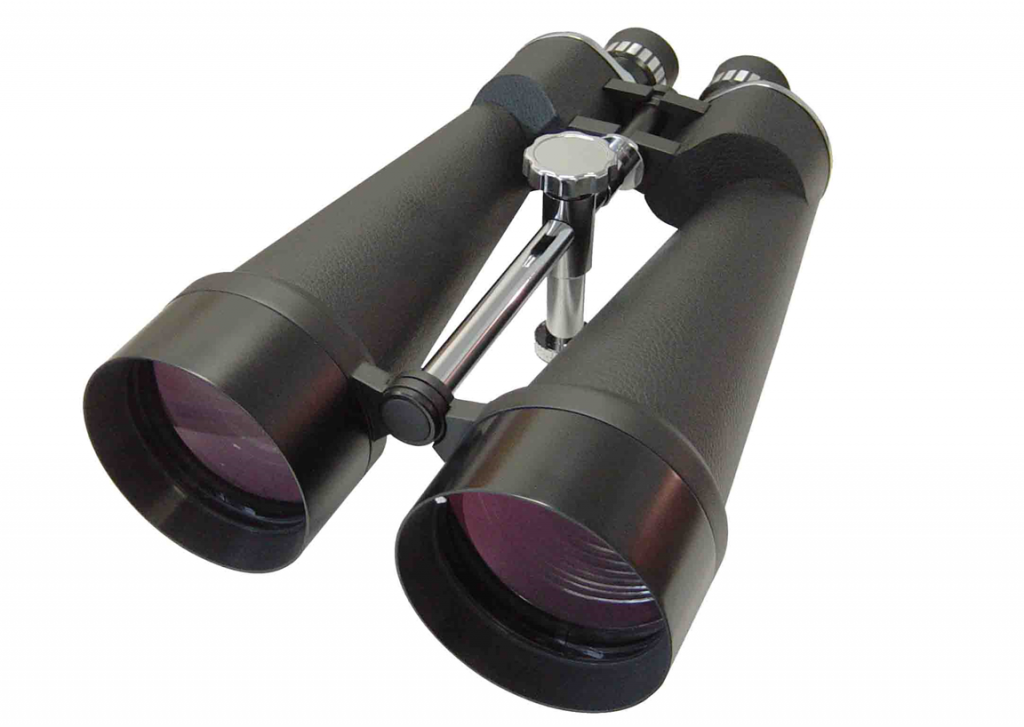
Here are my tips for using binoculars. To reduce shaking, hold the binoculars near the big objective lenses, except when focusing. When reclining in a chair, which I highly recommend for astronomy, prop your elbows on your chest to bear the weight of the binoculars. If standing, try to lean against something solid, or prop your elbows on a car roof or fence. To perfect the image focus, close the eye on the independent focus side and focus the binoculars with the main focus knob/wheel. Next, holding that focus, look through the closed eye instead and carefully focus the adjustable eyepiece. Lock that side in place, if possible. Each person’s focus is different. On humid nights keep the lens caps in place when you are not using the binoculars.
In a future Skylights I’ll highlight specific objects for binoculars.
The Moon
The moon will continue to shine brightly while it wanes following last Thursday’s Full Strawberry Moon. Evening skies worldwide will become increasingly dark because the moon will rise later each night and then lingering into the morning daylight. This moon will also commence its monthly visit with the planets gathered in the eastern pre-dawn sky.
The moon will clear the southeastern rooftops shortly after midnight tonight (Sunday). Its 94%-illuminated face will far outshine the medium-bright stars of Capricornus (the Sea-Goat) to its left (or celestial east). The brighter stars of the Teapot-shaped constellation of Sagittarius (the Archer) will be twinkling to the moon’s upper right. Early risers can watch for the moon low in the southwestern sky around sunrise.
The moon will wane a little in phase every night, rise about 20 minutes later, and linger longer into the morning. The moon will spend one more night in Capricornus and then pass through the stars of Aquarius (the Water-Bearer) from Wednesday to Thursday, shining from the wee hours until morning daylight.
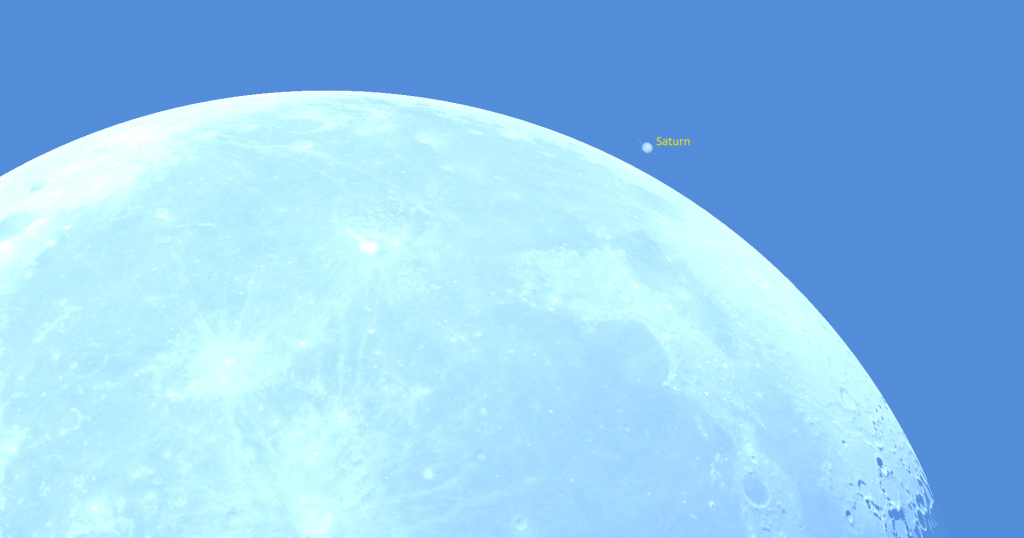
When the yellowish planet Saturn rises in the east in the early hours of Thursday morning, June 27, it will be shining less than palm’s width to the left (or 5 degrees to the celestial ENE) of the waning half-illuminated moon. The pair will be cozy enough for them to share the view in binoculars until the brightening sky hides Saturn at sunrise. On Friday morning, observers in eastern Australia and the region surrounding Fiji can watch the moon cross in front of, or occult, Saturn in a dark sky. In the Americas, it will happen in daytime. Unaided eyes will work, but binoculars or any size of telescope will show the occultation even better.
The moon will also officially reach its third quarter phase (or last quarter) at 5:53 pm EDT, 2:53 pm PDT, or 21:53 Greenwich Mean Time on Friday. At third quarter the moon appears half-illuminated on its western, sunward side. Lunar phases occur independently of Earth’s rotation, so the observers in the Americas will see the moon while it is a bit more than half-lit on Friday morning, and then a bit less than half-lit on Saturday morning. Only folks located along longitudes passing through Kyiv, Istanbul, Cairo, and eastern Africa will see the precisely half-illuminated rise around midnight.
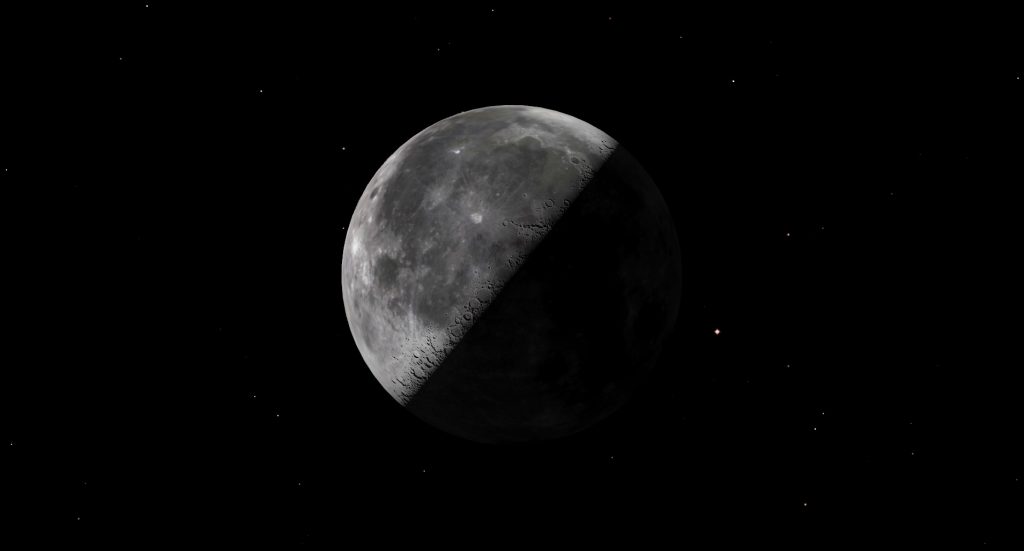
Third quarter moons are positioned ahead of the Earth in our trip around the Sun. About 3½ hours later, Earth will occupy that same location in space.
Astronomers always look forward to the arrival of the third quarter moon. For about ten evenings, starting with this phase each month, we can observe deep sky nebulae and galaxies without any pesky moonlight to interfere.
The moon will spend the coming weekend swimming with the stars of Pisces (the Fishes). A pretty sight will greet early risers because the moon will be shining between Saturn and reddish Mars, with bright Jupiter gleaming off to the lower left (or celestial east).
The Planets
With two weeks to go before the first of the outer planets, Saturn, joins the evening sky for the rest of 2024, we’re being treated to one of Mercury’s shorter visits after sunset. Mercury orbits the sun once every 88 days, its sidereal period, so its visibility oscillates between after sunset and before sunrise.
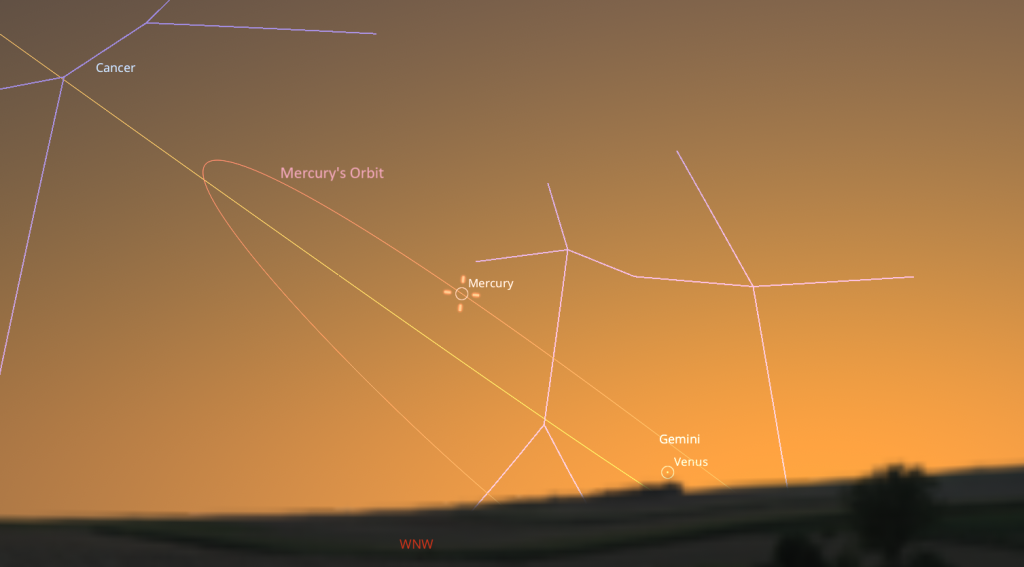
Mercury’s schedule isn’t that simple, though, because we are viewing it from the moving platform of Earth. It will climb away from the sun, stretch as much as 28 angular degrees from it, and then swing back – all in the span of two to four weeks. 28 degrees represents almost 2 hours of Earth’s rotation, but we seldom see the planet for that long on an evening or morning. We only see Mercury easily when the sun is far enough below the horizon for the sky to be darker. Mercury’s orbital inclination of 7° causes it to wander well north and south of the ecliptic, which holds the planet lower in the sky and harder to spot for some appearances. The speedy planet itself varies in brightness dramatically because it experiences phases (like the moon) and it also spends time closer to and farther from Earth.
This week, Mercury will start to appear just above the northwestern horizon after sunset. Every evening it will linger a little longer after sunset – so its visibility will be easier later in the week. Mercury’s evening apparition will be a lengthy and good one for mid-northern observers, but a so-so showing for those in the Southern Hemisphere. The best viewing window at the latitude of Toronto will be centred around 9:45 pm local time. Folks living closer to the tropics will have a better view. Binoculars will work well, but don’t use them until the sun has completely disappeared. Far brighter Venus will join Mercury in the coming weeks – and then stay for a spell when Mercury departs.

For the time being, you’ll need to head outside between the wee hours and dawn if you want to see any of the other planets. The medium-bright, yellowish dot of Saturn will rise around 12:45 am local time and then clear the rooftops in the east about an hour later. You’ll be able to see Saturn until almost sunrise. The planet will spend the next 10 months among the stars of eastern Aquarius (the Water-Bearer). Binoculars will show you an up-down row of five stars to Saturn’s right (or celestial west). A trio of blue-white stars huddling to Saturn’s lower right are named Psi1,2,3 Aquarii (or ψ1,2,3 Aqr). Several golden-coloured stars, including Phi and Chi Aquarii are spread out above them, to Saturn’s right.
Saturn’s rings, which will effectively disappear when they become edge-on to Earth next March, already look very narrow against the planet’s globe. Good binoculars can hint at Saturn’s rings and any telescope will show them to you. For telescope-owners, Earth’s perspective of the Saturn system this year and next will cause its moons to align in the plane of the rings and produce frequent transits of Saturn’s moons and their black shadows across its disk. Tethys’ tiny shadow will cross Saturn near the rings on Thursday morning between 1 and 3:30 am EDT.
Next Sunday, June 30, Saturn will cease its regular eastward motion through the distant stars of Aquarius and begin a retrograde loop that will last until mid-November. The apparent reversal in Saturn’s motion is an effect of parallax produced when Earth, on a faster orbit, passes the ringed planet on the “inside track”. You can observe the planet’s motion by noting how Saturn’s distance from the bright star to its right named Hydor (aka Lambda Aquarii) varies over the coming weeks. Don’t forget to check out the moon’s visit and occultation of Saturn on Thursday-Friday.
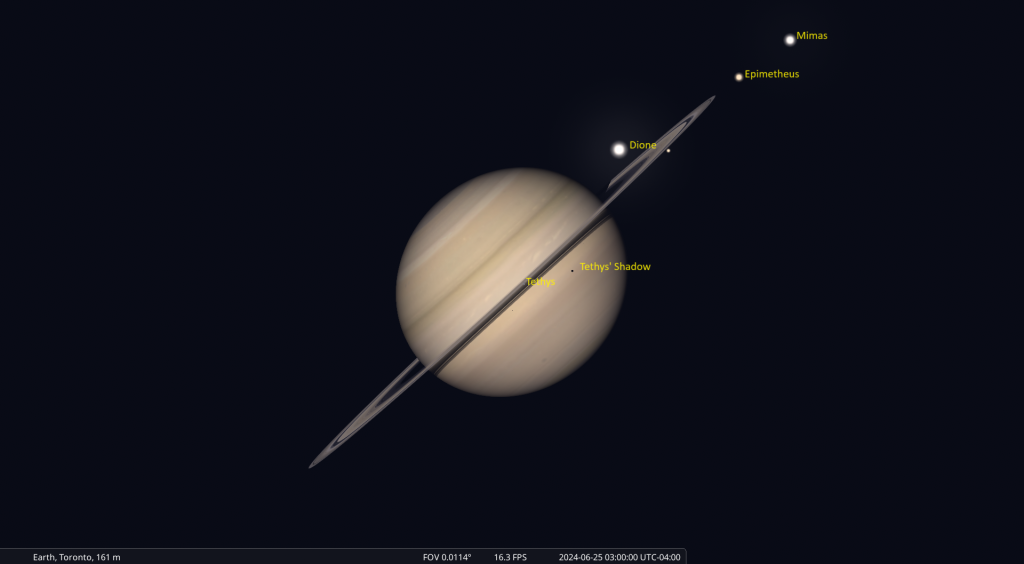
The planet Neptune will rise about 20 minutes after Saturn. The remote, blue planet will spend this year in western Pisces (the Fishes), a generous fist’s width to the lower left (or 11° to the celestial ENE) of Saturn. Neptune will also be located a bit more than a thumb’s width to the upper left (or 2° north) of a medium-bright star named 27 Piscium. They’ll share the view in binoculars. Other less-brilliant stars nearby named 29 Piscium, 24 Piscium, and 20 Piscium will help guide you to Neptune with a backyard telescope or good, strong binoculars. You’ll need to look at Neptune while the sky is dark (before about 4 am local time) – but the bright morning moon will overwhelm Neptune when it cruises by it later this week.
Reddish Mars will rise by 2:40 am local time and remain in sight until dawn. If the sky is still dark, the brightest stars of Aries (the Ram) will twinkle above Mars. Mars will look a little brighter than Saturn. In a telescope, Mars will display a small, ruddy disk. Its position on the far side of the sun from Earth will keep the planet looking small until later this year. While everything else rises earlier each week as the sky shifts west due to Earth’s motion around the sun, Mars is traveling the other direction, like a fish holding its location in a moving river. That’s why Mars isn’t yet rising much earlier.

Although Uranus will rise next, at about 3 am, the brightening sky will make seeing the planet harder. To aid in your search, seek out the pretty, prominent Pleiades star cluster in your binoculars. Uranus will be positioned a palm’s width to its right. Folks with an unobstructed horizon towards the ENE can look for far brighter Jupiter after it rises around 3:50 am local time. The sky will be light by the time Jupiter clears the trees. Be sure to turn all optical aids away from the eastern horizon before the sun rises.
Public Astronomy-Themed Events
Every Monday evening, York University’s Allan I. Carswell Observatory runs an online star party – broadcasting views from four telescopes/cameras, answering viewer questions, and taking requests! Details are here. They host in-person viewing on the first clear Wednesday night each month. Other Wednesdays they stream views online via the observatory YouTube channel. Details are here.
On Sunday, June 30 from 12:30 to 1 pm EDT, head to the David Dunlap Observatory for in-person DDO Sun Fun. Safely observe the sun with RASC Toronto astronomers! During the session, which is for ages 5 and up and runs rain or shine, a DDO Astronomer will answer your questions about our closest star – the sun! Registrants will learn how the sun works and how it affects our home planet, view the sun through solar telescopes, weather permitting, and visit the giant 74” telescope. More information is here and the registration link is at ActiveRH.
Keep your eyes on the skies! I love getting questions and requests. Send me some!